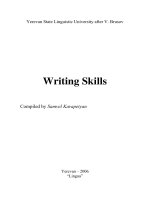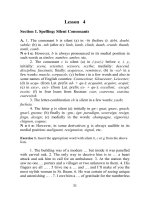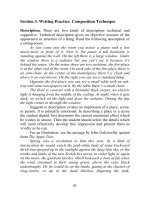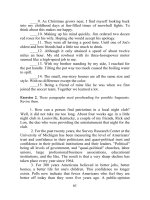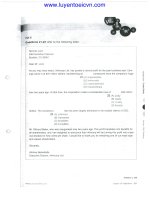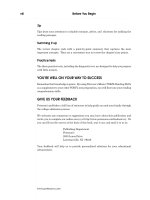Reading Module 3
Bạn đang xem bản rút gọn của tài liệu. Xem và tải ngay bản đầy đủ của tài liệu tại đây (3 MB, 76 trang )
UNIVERSITY OF ECONOMICS HO CHI MINH CITY
SCHOOL OF FOREIGN LANGUAGES FOR ECONOMICS
READING
(Module 3)
READING 1: E-MAIL: FOR AND AGAINST
Activity 1: What irritates you most about these forms of communication?
e-mail
mobile phone
conference calling
voicemail
BlackBerry
web presentation
…………………………………………………………………………………………………………
…………………………………………………………………………………………………………
Activity 2: What are the advantages and disadvantages of using e-mail?
Activity 3: Useful Vocabulary
Word/Phrase
Part of
Speech
Definition and Example
impetuous
fester
bizarre
medium
chronic
reprimand
2
hypocrisy
uncivil
discreet
dictate
Activity 4: Read the article quickly and choose the best title.
1. Time to switch your BlackBerry off
2. How to deal with your inbox
3. A quiet word beats sending e-mail
A quiet word beats sending e-mail
Luke Johnson
E-mail might just be responsible for the productivity increases that economists tell us are the key to
rising prosperity. But it could also be sending us all mad.
The truth is that business is generally best done face to face, and if that is impossible, then speaking
via the phone. But too many of us now hide behind silent, typed communications. The trouble is
that the recipient of an e-mail does not hear a tone of voice or see a facial expression; nor can the
sender modify their message halfway through, sensing that it is causing offence. When you read an
e-mail you cannot tell the mood of the e-mailer.
A permanent written form is deadly if you are feeling impetuous and emotional. Too often I have
made the mistake of sending an irritable response, which will have festered and angered the other
3
end much more than a difficult telephone exchange. Spoken words fade, but e-mail is forever.
It is so much easier to be tough via e-mail, or to get away with weak excuses, or to make things up,
or to say no. Almost invariably, it is more human and serious to have a real discussion rather than a
bizarre online conversation. I know employees who have been fired for sending abusive e-mails, or
who have faced severe legal consequences for writing something they should have just said
verbally.
Everyone in business finds their inbox is almost swamped every day with spam. I notice I spend
longer and longer sorting out the e-mails that matter from all the junk. It has become, I’m afraid, a
dangerously corrupted medium. Large companies suffer chronic overuse of “reply to all”.
Moreover, e-mail can be a terrible distraction, especially if you use a BlackBerry. I was recently
reprimanded for peeking at mine during a board meeting – a gross form of hypocrisy on my part,
because I once threatened to sling out of the window any PDA-type devices being used in meetings
I chaired. I have now vowed to switch off both BlackBerry and mobile in all meetings – anything
less is uncivil.
It must be admitted that e-mail is hard to beat as a transmitter of documents and data. It forces the
sender to carefully think through their arguments and express themselves logically. It allows you to
reply swiftly to a host of different questions when time is short. You don’t have to worry about
journey times or travel costs, unreliable postage or engaged phones or voicemail.
E-mail is a marvellously economical tool for keeping in touch with far-flung commercial contacts;
you can send them a note at your leisure, 24 hours a day. It is also is a terrific method of discreetly
and directly pitching to someone powerful. It certainly beats trying to get a meeting or even reach
them on the phone.
Like it or not, I could not do my job without e-mail. Meanwhile, I know a senior financier, an exchair of a FTSE company, who still has his secretary print out his e-mails for him to read so he can
then dictate replies for her to e-mail back. Now that really is mad.
Activity 5: Read the article again and list the advantages and disadvantages of using e-mail.
4
Does the writer mention any that you listed in Activity 2?
Activity 6: Find expressions in the article which mean the following.
1. looking at another person (paragraph 2)
2. upsetting or embarrassing someone by being rude or tactless (paragraph 2)
3. not be caught or punished when you have done something wrong (paragraph 4)
4. pretend something is true in order to deceive people (paragraph 4)
5. keeping writing or talking to someone, even though you do not see them often
(paragraph 8)
6. aiming a n idea or product at someone (paragraph 8)
Activity 7: Complete this text with the expressions in Activity 6 in the correct form.
I don’t have a problem with him …………… (1) his family whilst he’s posted overseas and sending
e-mails in office time. That’s not the main issue. However, if he thinks he can …………… (2)
sending such abusive e-mails to colleagues, he is sadly mistaken and he’ll have to face the
consequences of his actions later. He is clearly …………… (3) about his colleagues and spreading
nasty rumours. He’d be better off speaking to colleagues …………… (4) if he has problems with
them. He’s slightly better when speaking with customers, but he needs to think about who he's
speaking to when he’s …………… (5) our products to them. And he just doesn’t know how to say
no to people without …………… (6).
Activity 8: Discuss these questions.
1. “Business is best done face to face.” Do you agree?
2. How could communication be improved in your organisation?
3. How will communication change in the office of the future?
4. What do you do when you receive a nasty e-mail?
5. Is communication better these days with all the new technology?
5
READING 2: CORPORATE COMMUNICATION
Activity 1: Before you read.
Think about the biggest company in your country. What is its reputation?
…………………………………………………………………………………………………………
…………………………………………………………………………………………………………
Activity 2: Useful Vocabulary
Word/Phrase
Part of
Speech
Definition and Example
corporate
mistrust
prevail
evolve
manipulate
receptive
reevaluate
disruption
constituency
6
tremendous
Activity 3: Read the article from the Financial Times by Paul Argenti and do the exercises that
follow.
Time for communication to move towards centre stage
Paul Argenti
The last few years have seen the biggest collapse in confidence in business in almost a century - to
the point where probably the least trusted spokespeople on the planet today are corporate
executives. When intense mistrust prevails, whatever a company does says something about it,
everything communicates, and communication affects everything.
This is changing the definition of communication. Communication today is more of a two-way
dialogue and this has been aided by the rise of social media like Facebook and Twitter and the
explosion of information-sharing online. Today’s best-in-class companies, such as Dell in the US
and Philips in Europe, do not just engage in dialogue. They use the latest technology as a source of
ideas, opinions and competitive intelligence, for product development, employee engagement and
media monitoring.
In addition to rethinking the definition of communication, the best companies are rethinking its
structure. There is a greater need for integration, collaboration and partnership among corporate
leadership, human capital, finance, sales and legal teams.
Another change in communication by leading companies is the rethinking of key themes. This was
the main finding of research by the Tuck School of Business at Dartmouth, conducted with
Doremus, a business-to-business communications agency. It found that the best-in-class companies
have been guided by six themes:
a. Focus on value and values. Stakeholders demand value for money when buying goods and services, but they also expect to see a strong set of corporate values in the companies with which they
7
do business. Walmart, Hyundai and BMW have used this theme in their advertising and
communications.
b. Evolve a sense of responsibility. Corporate responsibility today is not just about philanthropy or
being green. It is about companies being responsible across all business practices. NGOs,
consumers, employees and investors are ready to punish companies that ignore evolving social
values. JPMorgan Chase has done a fabulous job reflecting its corporate responsibility initiatives on
its website and in advertising.
c. Strategy must drive communication. As Jon Iwata, IBM’s senior vice-president for marketing
and communications, puts it: “Lincoln said, ‘Character is the tree; reputation is the shadow.’ I’m
afraid too many people in PR, marketing and advertising spend more time manipulating the shadow
than tending to the tree.”
d. Shifting from the problem to the solution. Stakeholders are most receptive to realistic and
optimistic plans, and are often ready to pay so less attention to problems of the past year.
e. Not communicating is a communication in itself. You either tell your story or have it told for
you.
f. Re-evaluate positioning. The crisis has led to disruption in how companies are thought of by
constituencies, which provides a tremendous opportunity to reposition, rebrand and redevelop.
Activity 4: Find words from the article, and related words, to complete the table.
Verb
collaborate
Noun
collapse
define
engage
explode
find
prevalence
research
Activity 5: True or false? (paragraphs 1-4)
a. There is great mistrust of companies at the moment.
8
b. When there is mistrust, everything that companies do is misunderstood.
c. Corporate communication is seen as increasingly two-way.
d. The best companies have just continued to use their traditional public relations departments in
order to communicate.
e. In their new approach to communication, companies have been paying attention to five things
in particular.
Activity 6: Find expressions (paragraphs 5-6) that refer to the following:
a. a subject that can be used in different forms of communication (5 letters)
b. what people expect when they buy a company’s products (5 letters)
c. what they expect to see as guiding a company’s behaviour (6 letters)
d. employees, shareholders, suppliers and, above all in this context, customers (12 letters)
e. giving money to charity (12 letters)
f. having good environmental policies (5 letters, letters)
g. things that society as a whole thinks are important (6 letters, 6 letters)
h. actions that have not been taken before (11 letters)
Activity 7: Imagine company board meetings where directors say these things (1-6). Which
point a-f (paragraphs 5-10) is each director most closely referring to?
1. “We have to have a press conference and be open about our quality problems – if we don’t talk
about it and journalists get on to the story, we’re in big trouble!”
2. “Our customers are getting real value for money when they buy our products, and they also
have the reassurance of knowing they are dealing with a socially responsible organisation!”
3. “We mustn’t let this crisis go to waste! It gives us the chance to reposition ourselves as the
most environmentally aware energy company in the world.”
4. “Corporate social responsibility isn’t something we can just leave to the CSR people – it
involves all of us!”
5. “Let’s not keep talking about our past problems. Instead, let’s look forward to the exciting new
possibilities that exist for the future!”
6. “There’s too much emphasis here on public relations and slick advertising. If we behave
responsibly, our corporate image will take care of itself.”
9
Activity 8: Choose the best summary for the whole article.
a. Corporate communication is a speciality that is best left to the PR department and advertising
agencies.
b. Everything a company does communicates something about it, and executives are becoming
increasingly aware of this.
c. Whatever a company does, people will always misinterpret its actions, and companies just have
to try to limit the damage.
Activity 9: Discuss these questions.
1. “Lincoln said, ‘Character is the tree; reputation is the shadow.’ I’m afraid too many people in
PR, marketing and advertising spend more time manipulating the shadow than tending to the
tree.” How far is it possible to ‘manipulate’ the truth about an organisation’s character?
2. Think about your organisation or one you would like to work for. In what ways can each
department show that it is responsible? How can this be communicated?
10
UNIT 2: INTERNATIONAL MARKETING
READING 1: ITALIAN LUXURY
Activity 1: Answer these questions.
1. What do the following have in common: Gucci, Chanel, Calvin Klein, Louis Vuitton, Christian
Dior, Versace, Giorgio Armani, Ralph Lauren, Prada, Yves Saint Laurent?
…………………………………………………………………………………………………………
.
2. Which countries tend to make the world's most desirable luxury brands?
…………………………………………………………………………………………………………
.
3. What would you buy if money was no object?
…………………………………………………………………………………………………………
.
Activity 2: Useful Vocabulary
Word/Phrase
Part of
Speech
Definition and Example
powerhouse
discerning
deliberate
glamour
intent
aspire
11
relentless
groundwork
dilute
sceptical
Activity 3: Read the article below quickly and complete this information.
Tod's group HQ - where?
………………………….. (1)
Key products
………………………….. (2)
Chairman
………………………….. (3)
Competitors that Chairman admires
………………………….. (4)
New markets
………………………….. (5)
Objective in next five years
………………………….. (6)
Diego Della Valle: Italian atmosphere is central to Tod’s global
expansion
Vincent Boland
It is not too difficult, in the high-ceilinged elegance of Palazzo Della Valle on the Corso Venezia in
Milan, to be seduced by the charms of a certain kind of Italian lifestyle. Here is the headquarters of
Tod’s Group, which has become a powerhouse in the marketing of that vision to the world’s wealthy
and discerning.
The atmosphere is deliberate: where some Italian fashion houses have expanded ever further into
the realms of celebrity and glamour, Tod’s is anchored as firmly as it can be to its family roots and
its traditional, hand-made, century-old heritage.
12
Its signature products – shoes and bags – are made of leather, a raw material that has remained
almost unchanged since it was first discovered. A new advertising campaign will take the company
back to basics, with a focus on Italian families and their lifestyles – actual Italian families, however
rich and privileged – rather than on celebrities.
“The Italian lifestyle is in our DNA, and in our group, we believe in our DNA,” says Diego Della
Valle, the chairman and chief executive of Tod’s Group.
This image is especially important in new markets, such as China and India, he says. In common
with other luxury-goods makers, he is intent on capturing consumers in those markets who aspire to
the same sense of the Italian lifestyle as do customers in more mature markets. “A luxury goods
company has to have control of its image,” he says. “For Tod’s, the thing is to communicate this
tradition, the generations of work that have gone into our products. For us it’s an absolute priority.”
To achieve it, one must put quality before quantity, and one must maintain the group’s traditions
even as it globalises, which it has been doing fairly relentlessly in the past decade.
The challenge is to marry tradition with modernity in a way that not all Italian luxury goods and
fashion producers have managed. Tod’s has done it, Mr Della Valle says, by maintaining one key
vision: “We’re a luxury goods company, not a fashion company.”
This distinction between fashion and luxury is central to Mr Della Valle’s global ambitions. The two
have different products and ought to have different strategies, he says. The competitors he admires
most, he says, are Louis Vuitton, Hermès and Chanel.
Mr Della Valle says that the goal in the next five years is “to complete the globalisation” of Tod’s,
for which he has been laying the groundwork. “I’d like Tod’s to be much bigger than it is now,
without diluting the brand,” he says.
He expects China and India to account for as much as 25 per cent of revenues by then, because the
growth potential is much higher than in more traditional markets. “There is a much bigger appetite
for luxury goods in those markets than in mature markets, and day by day more people are coming
13
into this market.”
But as for China as a competing producer, Mr Della Valle is sceptical about its ability to produce
luxury goods. “It lacks the structure of small companies, the tradition, the concept of excellence”
that Italian luxury-goods producers have inherited and which they must maintain as a competitive
advantage, he says. “Made in Italy doesn’t necessarily mean expensive goods,” he says. “It means
excellent goods.”
Activity 4: Read the article again and correct this summary.
Tod's Group wishes to convey the charms of the Italian lifestyle to the world's rich. To do this, it
focuses on celebrity and glamour, and its new advertising campaign will feature Italian celebrities.
The Chairman says he wants to expand into India and China to capture consumers there who
appreciate the Italian lifestyle. To enter such big markets, Tod's will need to think about quantity as
well as quality.
Tod's is primarily a fashion company and needs to be much bigger. China and India have more
possibility for growth than Tod's traditional markets. The Chairman is worried because China will
be able to produce luxury goods more cheaply. In future, Tod's will look to lower production costs
by manufacturing in low-cost countries.
Activity 5: Match words from each column to make word partnerships. Then check your
answers in the article.
1. competitive
a. markets
2. traditional
b. markets
3. raw
c. advantage
4. mature
d. materials
5. global
e. ambition
Activity 6: Discuss these questions.
1. What products do you know that rely on their heritage and cultural background?
2. In a recession, do you think companies such as Tod's should manufacture in low-cost countries
rather than at home? What are the advantages and disadvantages of this?
3. Would you ever buy a fake luxury product?
4. Do you agree that designer luxury goods are always higher quality than non-designer goods?
14
READING 2: GLOBAL BRANDS
Activity 1: Before you read.
Which do you think are the top ten brands in the world at the moment, in terms of their value?
Make a list.
………………………………………………………………………………………………………
……………………………………………………………………………………………………....
………………………………………………………………………………………………………
……………………………………………………………………………………………………....
Activity 2: Useful Vocabulary
Word/Phrase
Part of
Speech
Definition and Example
recession
preach
comply
scenario
outperform
sustainable
outrank
unabated
15
tribute
embody
Activity 3: Read the article from the Financial Times by John Gapper and do the exercises
that follow.
Big names prove worth in crisis
John Gapper
For companies whose financial value depends heavily on the health of their brands, the severity and
abruptness of the recession was a challenge. The abruptness with which many consumers stopped
spending, and large companies reduced capital investment, caused a shock to the system. Many
companies experienced not only the financial crisis, but also a crisis of confidence.
Marketers and advertising agencies preach the gospel that the companies that emerge best out of
recessions are those that maintain their marketing budget and protect brands when the going gets
tough. In practice, few companies were certain enough of the future to comply. Yet some of the
Doomsday scenarios about the value of brands in the post- recession world have not come to pass.
Emerging from the recession, luxury goods companies and many other consumer brand companies
are enjoying a rebound.
The underlying value of any brand – the premium commanded by products and services with strong
reputations and identities – has not been eliminated by the crisis. Even those companies that did not
invest heavily in their brands in the worst times are regaining some confidence. “Brands outperform
in good times and when there is a recession they do go down, but they come out the other side with
a sustainable advantage,” says Joanna Seddon, chief executive of MBO, the organisation that
compiles the ranking.
The nature of brands continues to evolve. Technology rather than marketing is now the defining
16
characteristic of seven of the top 10 brands, with Coca-Cola, McDonald’s and Marlboro making up
the other three. Google remains the world’s most valuable brand, but edging up close behind it are
two other technology companies, IBM and Apple. Both of these outrank Microsoft, whose brand
value was stable during the year. The resurgence in Apple under Steve Jobs, through the iPod, the
iPhone and now the iPad, continues unabated and, on present trends, it could be pressing Google for
first place within a year or two. That is a tribute to a company that inspires devotion among
customers.
It may also be a reflection of the value of inspirational leadership, and the way in which consumers
identify some of the world’s most valuable brands, such as Oracle and Starbucks, with founders
who embody their qualities. Larry Ellison of Oracle and Howard Schultz of Starbucks are not only
the founders but keepers of the flame. The social media boom led by companies such as Facebook
and Twitter - as well as the rise in smartphones led by Apple – has had a broader impact on the top
100. It has boosted mobile operators such as Verizon and AT&T, despite the complaints of iPhone
users about AT&T’s 3G coverage.
Activity 4: Complete this table with words and grammatically related words from paragraph
1.
noun
adjective
abrupt
confident
healthy
finance
severe
valuable
Activity 5: Now match the adjectives above to their meanings.
a. in good condition
b. very difficult
c. worth a lot of money
d. feeling good about the future
e. very sudden
f. relating to money
Activity 6: Use forms of expressions from paragraph 2 to correct these statements.
17
a. If you say that something is true and that people should act in accordance with it, you preach the
bible about it.
b. If conditions become difficult in a particular situation, the journey gets hard.
c. A series of very bad events that might happen is a fateful narrative.
d. A formal way of saying that something has happened is to say that it has come past.
e. If a company does well after a period of doing badly, it undergoes a bounce.
Activity 7: True or false? (paragraphs 2-3)
a. The value of brands was completely destroyed during and after the recession.
b. Companies that did not invest in their brands have been totally eliminated.
c. The value of brands goes down during recessions.
d. Companies with valuable brands do better than those without in the long run.
Activity 8: Which of the brand(s) mentioned in paragraphs 4-5.
a. relate to technology-based companies or their products?
b. relate to non-technology companies?
c. is top in the rankings?
d. is technology-based, and below three other technology companies?
e. are names of products related to a technology company?
f. have grown partly because of the success of other brands?
Activity 9: Find expressions that refer to (paragraphs 4-5).
a. the thing that people think about most in relation to a brand. (8 letters, 14 letters)
b. a period of success following a period of decline. (10 letters)
c. makes you admire a person, brand, etc. (8 letters)
d. a feeling of complete admiration, respect, etc. (8 letters)
e. company founders who are still building their companies. (7 letters, 2 letters, 3 letters, 5 letters)
f. companies such as Facebook and Twitter. (6 letters, 5 letters)
Activity 10: Discuss these questions.
1. Look again at the list of brands that you made before you read the article. Compare it with the
answers to activity 8. Were there any surprises for you? If so, describe them.
2. Which of the above brands will still be important 10 years from now, and which will have
18
declined? Give your reasons.
19
UNIT 3: BUILDING RELATIONSHIPS
READING 1: BUSINESS NETWORKS IN CHINA
Activity 1: Where can you meet people to build good business relations?
…………………………………………………………………………………………………………
Activity 2: Useful Vocabulary
Word/Phrase
Part of
Speech
Definition and Example
notion
plain
nouveau riche
astute
imperative
wannabe
alumnus
alumni
(plural)
invariably
savvy
20
Activity 3: Read the article quickly and say who these people are.
1. Li Ka-shing
2. Gary Wang
3. Helen Wong
4. Zhou Junjun
5. Andrew Grant
How East is meeting West
Frederik Balfour
Guanxi. It’s the first word any businessperson learns upon arriving in China. Loosely
translated, guanxi means “connections” and it is the key to everything: securing a business license,
landing a distribution deal, even finding that special colonial villa in Shanghai. Fortunes have been
made and lost based on whether the seeker has good or bad guanxi.
Now, like so many things in China, the old notion of guanxi is starting to make room for the new.
Businesspeople – local and foreign – are tapping into emerging networks that revolve around shared
work experiences or taking business classes together. Networking that once happened in private
rooms at smart restaurants now goes on in plain view – at wine tastings for the nouveau riche, say,
or at Davos-style get-togethers such as the annual China Entrepreneurs Forum held annually at
China’s Yabuli ski resort. By tapping into these informal groups, Western companies can
theoretically improve their understanding of the marketplace, hire the best talent, and find potential
business partners.
Guanxi goes back thousands of years and is based on traditional values of loyalty, accountability,
and obligation – the notion that if somebody does you a favor, you will be expected to repay it one
day. One of Asia’s most successful businessmen, Hong Kong billionaire Li Ka-shing, has used
his guanxi particularly astutely over the years, in the process winning valuable licenses and
permission to build huge real-estate developments. Playing the guanxi game is still imperative,
especially for foreign investors.
Many of China’s networkers meet through an American or European MBA program. Gary Wang
attended INSEAD, the famous French business school outside Paris. Today, he runs a YouTube
21
wannabe called Tudou that was built largely on connections made at business school. A fellow
student who worked at Ogilvy & Mather Worldwide helped out with public relations. And another
INSEAD graduate, Helen Wong, a partner at Granite Global Ventures, helped Wang raise $8.5
million after a friend heard him speak at the China Europe International Business School (CEIBS)
in Shanghai. “Without knowing all these people through INSEAD,” says Wang, “Tudou probably
never would have happened.”
Executive MBA programs, all the rage now in China, have become Guanxi Central. Targeted at
senior executives and high-powered entrepreneurs, the programs are attracting some of China’s
most successful businesspeople. “It’s important to have friends in different industries and meet
people from different cities,” says Zhou Junjun, who runs the Chinese operations of a South Korean
systems company and did an Executive MBA at the Cheung Kong Graduate School of Business in
Beijing.
Multinational companies, of course, provide rich opportunities for networking, too. Ogilvy Public
Relations Worldwide holds an annual party for former employees, many of whom now work for the
company’s clients, including Lenovo, Johnson & Johnson, and solar-panel maker Suntek. McKinsey
has plenty of alumni who have moved into senior posts at major companies and start-ups.
“Obviously, they became a valuable network for us,” says Andrew Grant, who runs the firm’s China
practice in Shanghai.
If one thing has remained the same for foreigners in China, it is this: cracking the guanxi code still
takes hard work and perseverance. Networking at an alumni barbecue or wine tasting goes only so
far when trying to build relationships of any lasting value. After the first 30 minutes at these
functions, say people who have attended, foreigners and locals almost invariably break off into
separate groups.
What’s more, Chinese businesspeople are more experienced and globally savvy than they were just
a few years ago. They’re looking for business connections who can help them expand outside China
or get their company listed on a foreign exchange. “People want something more professional and
strategic from their relationships,” says Li Yifei, Viacom’s chief representative in China. “They
want to know how good your guanxi is back home.”
22
Activity 4: Read the article again. Which paragraph:
1. begins by talking about the origins of guanxi?
2. gives examples of what can be achieved if you have connections?
3. talks about how guanxi is changing?
4. talks about top connections made at M BA programmes within China?
5. talks about how a business started through connections made at a European business school?
6. talks about networking through multinational companies?
7. talks about Chinese businesspeople wanting something in return for connections?
8. suggests that making connections might take time and effort?
Activity 5: Answer these questions.
1. What is guanxi?
2. What examples are given of things you can achieve if you have good guanxi?
3. What can Western companies do if they are involved in informal groups?
4. How is guanxi changing?
5. Why does Ogilvy Public Relations Worldwide hold annual parties for previous employees?
Activity 6: Find words or phrases i n the article which mean the following.
1. using or taking what you need from a supply of something (paragraph 2)
2. when someone always supports someone o r something (paragraph 3)
3. being responsible for what you do and willing to explain it or accept criticism (paragraph 3)
4. a moral or legal duty to do something (paragraph 3)
5. people you know who can help you, especially because they are i n positions of power (paragraph
4)
6. talking to other people who do similar work in order to help each other (paragraph 6)
7. determination to keep trying to do something difficult (paragraph 7)
Activity 7: Discuss these questions.
1. What advice would you give to someone trying to develop business relationships
in China?
2. A foreign company is opening a branch in your country. What factors should it consider?
3. In your experience, are certain nationalities better at building relationships than
others? If so, which ones?
23
READING 2: WORKING FOR FREE
Activity 1: Before you read.
Would you be willing to do pro bono work – that is, to work without being paid? Why? / Why not?
…………………………………………………………………………………………………………
…………………………………………………………………………………………………………
Activity 2: Useful Vocabulary
Word/Phrase
Part of
Speech
Definition and Example
careerist
preserve
nuts and bolts
cozy
hierarchy
enlist
ethical
associate
privileged
24
counterpart
Activity 3: Read the article from the Financial Times by Rhymer Rigby and do the exercises
that follow.
The careerist: Pro bono work
Rhymer Rigby
Pro bono work is usually thought of as the preserve of lawyers, but organisations as varied as
advertising agencies and professional services firms also donate their staff’s time to good causes –
either for free or for reduced fees. Although employees should do pro bono work for selfless
reasons, your good deeds can also be rewarded in terms of your career.
How does pro bono work add to my experience?
If you are relatively junior, it can be a very good way to step up. “People who do pro bono work in
the Accenture Development Partnerships typically take on more senior roles than they would in big
corporate roles,” says Royce Bell, a senior executive at the consultancy firm. “You get to see a lot of
nuts and bolts and it’s very good to get outside the normal cosy corporate world. You’d think that
someone who sets up an IT system in Chad would have a broader view than a person who has only
worked in Fortune 200 companies.”
What about opportunities for building relationships?
Pro bono work often brings together people from different parts of organisations who might not
otherwise meet. Phil Georgiadis, chairman of Walker Media, the London agency, says it can cut
through hierarchies, too. “I’m about to do some work for the Great Ormond Street Hospital for
Children and I’ll enlist a couple of graduates to work with me – that’ll be the account team. So
suddenly you have a graduate who is reporting directly to the chairman, which is very rare,” he
explains.
What about job satisfaction?
Using your professional skills in the service of good causes often adds a kind of ethical dimension
25
